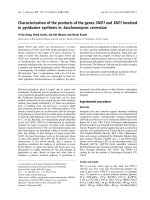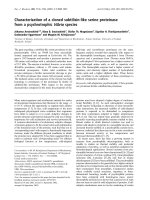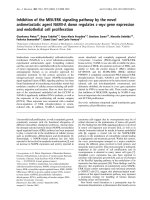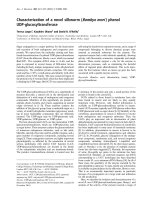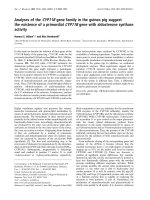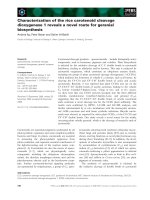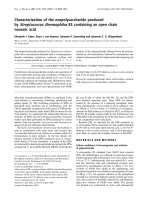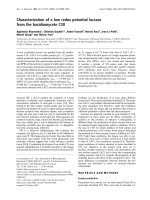Báo cáo Y học: Characterization of a Saccharomyces cerevisiae NADP(H)-dependent alcohol dehydrogenase (ADHVII), a member of the cinnamyl alcohol dehydrogenase family pptx
Bạn đang xem bản rút gọn của tài liệu. Xem và tải ngay bản đầy đủ của tài liệu tại đây (363.34 KB, 8 trang )
Characterization of a
Saccharomyces cerevisiae
NADP(H)-dependent
alcohol dehydrogenase (ADHVII), a member of the cinnamyl alcohol
dehydrogenase family
Carol Larroy, Xavier Pare
´
s and Josep A. Biosca
Department of Biochemistry and Molecular Biology, Universitat Auto
`
noma de Barcelona, Barcelona, Spain
A new NADP(H)-dependent alcohol dehydrogenase (the
YCR105W gene product, ADHVII) has been identified in
Saccharomyces cerevisiae. The enzyme has been purified to
homogeneity and found to be a homodimer of 40 kDa
subunits and a pI of 6.2–6.4. ADHVII shows a broad sub-
strate specificity similar to the recently characterized
ADHVI (64% identity), although they show some differ-
ences in kinetic properties. ADHVI and ADHVII are the
only members of the cinnamyl alcohol dehydrogenase family
in yeast. Simultaneous deletion of ADH6 and ADH7 was not
lethal for the yeast. Both enzymes could participate in the
synthesis of fusel alcohols, ligninolysis and NADP(H)
homeostasis.
Keywords: cinnamyl alcohol dehydrogenase; fusel alcohols;
NADP(H) homeostasis; ligninolysis.
The current version of the Yeast Proteome Database
() lists approximately 260 oxido-
reductases (160 of them have been characterized
experimentally, and the rest predicted by sequence
similarity or by other analysis) [1]. Our group is
interested in the identification and characterization of
novel alcohol dehydrogenase (ADH) gene products from
Saccharomyces cerevisiae [2,3]. ADHs are oxidoreductases
that catalyze the reversible oxidation of alcohols to
aldehydes or ketones, with the corresponding reduction
of NAD or NADP. ADHs constitute a large group of
enzymes that can be subdivided into at least three distinct
enzyme superfamilies: medium-chain and short-chain
dehydrogenases/reductases, and iron-activated alcohol
dehydrogenases [4,5]. The medium-chain dehydrogenase/
reductase (MDR) superfamily consists of enzymes with a
subunit size of approximately 350 residues, dimeric or
tetrameric, with two domains in each subunit: one
catalytic and one responsible for the binding of the
nucleotide (NAD or NADP). Many enzymes of the
MDR family have zinc in their active site, and have a
sequence motif known as the zinc-containing ADH
signature: GHEX
2
GX
5
(G,A)X
2
(I,V,A,C,S) [6]. According
to the Pfam and COG databases [7,8], the S. cerevisiae
genome codes for 21 potential MDR enzymes, with 12 of
them showing the zinc ADH signature described above.
These 12 zinc-containing yeast MDR include ADH1,
ADH2, ADH3, ADH5, ADH6, SFA1, SOR1 and its
99% identical YDL246C, XYL2, BDH1, YAL061W and
YCR105W. All these yeast MDRs, except YCR105W
and YAL061W, have enzymatic activities experimentally
determined. In the present study, we report the charac-
terization of the YCR105W gene from S. cerevisiae as a
new alcohol dehydrogenase. The gene was overexpressed
in yeast cells and the corresponding protein product
purified to homogeneity. The enzyme showed a wide
substrate specificity, using NADP(H) as coenzyme. Given
the similar substrate specificities and the sequence identity
(64%) between the Ycr105p and the recently character-
ized ADHVI [3], we propose the name of ADH7,forthe
YCR105W gene and ADHVII for its coded protein. A
null adh7 yeast strain and a double mutant adh6D adh7D
were constructed and their growths compared with a
wild-type strain.
MATERIALS AND METHODS
Yeast and bacterial strains and plasmids
For cloning procedures we used the Escherichia coli XL1-
Blue strain from Stratagene (Amsterdam, the Netherlands).
The S. cerevisiae yeast strain S288C [9] was used to amplify
the YCR105W gene by PCR. The protease deficient yeast
BJ5459 (MATa, ura3–52, trp1, lys2-801, leu2D1, his3D200,
pep4::HIS3, prb1D1.6R, can1 GAL) [10] was used to purify
Ycr105p (ADHVII). The yeast strains BJ2168 (MATa, leu2,
trp1, ura3–52, prb1-1122, prc1-407, pep4-3, gal2) [10] and
BJ18 (MATa, leu2, trp1, ura3–52, adh6::TRP1, prb1-1122,
prc1-407, pep4-3, gal2) [3] were used to delete the YCR105W
gene.
The galactose-inducible E. coli yeast shuttle vector pYes2
(carrying the selective URA3 marker and the upstream
activating and promoter sequences of GAL1) purchased
from Invitrogen (Groningen, the Netherlands) was used to
clone and overexpress the YCR105W gene in the yeast
strain BJ5459. E. coli was grown at 37 °CinLBmedium
Correspondence to J. A. Biosca, Department of Biochemistry and
Molecular Biology, Faculty of Sciences, Universitat Auto
`
noma
de Barcelona, E-08193 Bellaterra (Barcelona), Spain.
Fax: + 34 93 5811264, Tel.: + 34 93 5813070,
E-mail:
Abbreviations: ADH, alcohol dehydrogenase; MDR, medium-chain
dehydrogenase/reductase; YPD, a rich medium (yeast extract,
peptone and dextrose) used to grow yeast.
(Received 29 July 2002, revised 1 October 2002,
accepted 7 October 2002)
Eur. J. Biochem. 269, 5738–5745 (2002) Ó FEBS 2002 doi:10.1046/j.1432-1033.2002.03296.x
supplemented with 50 lgÆmL
)1
of ampicillin to select for the
desired plasmid constructs. The yeast cells were grown at
30 °C in minimal medium without uracil supplemented with
2% glucose or galactose to allow for the selection and
induction of the yeast transformed with the pYes2 con-
structs. YPD (1% yeast extract, 2% peptone, 2% glucose)
wasusedtomonitorthegrowthoftheadh7D and
adh6Dadh7D mutants.
Cloning methods
All DNA manipulations were performed under standard
conditions as described [11]. The YCR105W gene was
amplified by PCR from the genomic DNA from the
S. cerevisiae S288C strain using the oligonucleotides
5¢GGC
GAGCTCAAAATGCTTTACCCAGAAAAATT
TGAGG-3¢ and 5¢GGC
TCTAGACTATTTATGGAA
TTTCTTATC-3¢ that introduced SacIandXbaIsites
(underlined), respectively, at their 5¢ ends. The PCR was
startedwithaÔhot startÕ of 5 min at 95 °C that was followed
by 30 cycles of 1 min at 95 °C, 1 min at 55 °C and 1 min of
extension at 72 °C, and a last cycle of 3 min extension at
72 °C. The PCR was performed in a 100-lL volume that
contained 1 unit of Vent DNA polymerase, 1 l
M
of each
primer, 200 l
M
dNTPs and 3 m
M
MgSO
4
.
The amplified fragment, purified from an agarose gel, was
cloned into the SacI/XbaI sites of pYes2 and the resulting
construct was called pY105. The construct was sequenced in
both directions (Oswell DNA Services, Southampton, UK)
to verify that there had been no mutations introduced by the
PCR.
Purification of ADHVII
BJ5459[pY105] cells over expressing ADHVII in galactose
medium were chosen as starting material to purify
ADHVII. They were grown in 2 L of minimal medium
supplemented with 2% galactose as carbon source and all
the auxotrophic requirements except for uracil (to main-
tain the selection for the plasmid). The cells were collected
at an A
595
of 4.3, resulting in 12.5 g, that were
resuspended in one volume of 20 m
M
Tris/HCl, pH 8.0,
2m
M
dithiothreitol (buffer A). The crude extract was
prepared with glass beads of 0.5 mm diameter on a bead-
beater (Biospec Products). One volume of buffer A was
used to wash the glass beads and the total volume of
homogenate was centrifuged at 29 000 g for 1 h. The
supernatant was collected and dialysed against buffer A.
The dialysed extract was applied to a DEAE Sepharose
column (1.5 · 13 cm) equilibrated in buffer A. The
columnwaswashedwith200mLbufferAandthe
enzyme was eluted with a 0–0.3
M
NaCl linear gradient in
buffer A (300 mL). Fractions with activity were pooled,
concentrated and desalted. The final 6.1 mL obtained
from the DEAE chromatography were applied into a red
Sepharose column (1.5 · 15.5 cm) equilibrated in buffer
A. After a wash with 200 mL buffer A, the enzyme was
eluted with a linear gradient from 0 to 2 m
M
NADP in
buffer A. The activity peak was collected and concentrated
before being applied into a Superdex 200-HR (1 · 30 cm)
connected to a Waters HPLC system. Chromatography
was performed in 50 m
M
NaH
2
PO
4
pH 7, 0.15
M
NaCl,
0.5 m
M
dithiothreitol and 20% glycerol at 0.4 mLÆmin
)1
.
This chromatography served also to estimate the enzyme
molecular mass, using M
r
markers from Sigma. The pure
protein was stored at )20 °C in this buffer. Protein
concentration was determined with the Bio-Rad reagent
using bovine serum albumin as standard [12].
Electrophoretic analysis
Denaturing SDS/PAGE was performed as described [13] in
gels containing 12% acrylamide. Proteins were stained with
silver nitrate. Native gel electrophoresis in 6% acrylamide
was performed in Tris/boric/EDTA buffer, pH 8. Gels were
incubatedfor15minonicein20m
M
BisTris, pH 7,
containing 1 m
M
NADPH for activity staining. A filter
paper, soaked in 10 m
M
pentanal, 20 m
M
BisTris, pH 7,
was placed covering the gels. After 5 min the filter paper
was removed and the gel exposed to UV light. Disappear-
ance of NADPH fluorescence, indicated aldehyde reduction
[14,15].
Enzyme activity
Kinetic parameters were determined at 25 °CinaCary400
spectrophotometer (Varian, USA). The reduction of alde-
hydes was assayed in 1 mL reaction mixture containing
33 m
M
NaH
2
PO
4
,pH7.0,0.2m
M
NADPH and 1 m
M
aldehyde by measuring the decrease of absorption at
340 nm. Signal was recorded at 365 nm with cinnamalde-
hyde, veratraldehyde, and anisaldehyde and at 400 nm for
coniferaldehyde, using previously reported molar extinction
coefficients [3]. The oxidation of alcohols was performed in
0.1
M
glycine, pH 10.0, 1.2 m
M
NADP and 10 m
M
of each
alcohol, by measuring the rate of reduction of NADP at
340 nm. A wavelength of 365 nm was used for cinnamyl
alcohol and of 400 nm for coniferyl alcohol oxidizing
activities (e
400
¼ 27.5 m
M
)1
Æcm
)1
at pH 10.0). One unit of
activity corresponds to 1 lmol of NADP(H) formed per
min.
The steady-state kinetic parameters with their associated
standard errors were determined by fitting the initial rate
values to the Michaelis–Menten equation with the help of
the computer program
LEONORA
[16].
Construction of the
adh7
D and
adh6
D
adh7
D mutant
strains
Deletion of YCR105W was carried out by the one-step gene
replacement [17] with the URA3 gene as a marker. An
internal coding region fragment of 443 bp was removed
from the YCR105W gene in pY105 by digestion with
BamHIandBclI. The BamHI fragment carrying the URA3
marker from YDpU [18] was inserted into the BamHI-BclI
sites after making blunt-ends. The resulting plasmidic
construction was used as template to amplify by PCR the
truncated gene carrying the URA3 marker. The yeast strains
BJ2168 and BJ18 were transformed with the truncated
ycr105w gene by using the lithium acetate method [19]. The
resulting mutant strains adh7D and adh6Dadh7D (named
BJ05 and BJ1805, respectively) were allowed to grow on
minimal medium plates supplemented with all the auxo-
trophic requirements except for uracil. All the resulting null
mutants were verified by PCR from their genomic DNA as
template.
Ó FEBS 2002 Yeast NADP(H)-dependent alcohol dehydrogenase (Eur. J. Biochem. 269) 5739
RESULTS AND DISCUSSION
Isolation and molecular properties of ADHVII
from
S. cerevisiae
In a previous report, we had characterized the yeast
YMR318C open reading frame [3]. We expressed and
characterized the corresponding protein, that resulted to be
a MDR NADP-dependent alcohol dehydrogenase, of wide
substrate specificity, named ADHVI. In that work, we
noticed a 64% sequence identity between the YMR318C
and YCR105W gene products, and we therefore assigned
this last protein as a putative NADP(H) dependent ADH
[3]. In order to confirm this assignation, we have now
purified Ycr105p, which we have named ADHVII, and
have studied its enzymatic activity. To have an abundance
of initial material, we overexpressed ADHVII with the aid
of a galactose-inducible vector in a protease-deficient yeast
strain (BJ5459[pY105]). To detect ADHVII in the yeast
homogenates, we measured the NADP(H)-dependent
activities towards several alcohols and aldehydes, known
substrates for ADHVI. The yeast extracts of the
BJ5459[pY105] strain showed a five- to 10-fold increase in
their NADP(H)-dependent specific activity towards several
alcohols and aldehydes, compared with BJ5459[pYes2],
used as a control strain. The reductase activity was about
fivefold the dehydrogenase activity, cinnamaldehyde being
one of the best substrates assayed. We therefore decided to
use the cinnamaldehyde reductase reaction to follow the
purification of ADHVII. Purification could be also followed
by native PAGE and activity staining of the gel with
pentanal and NADPH (Fig. 1). The enzyme was not
detected on lysates from cells grown on glucose (Fig. 1B,
lane 1), but its activity was clearly visible (upper band in lane
2) in the homogenates from yeast grown in galactose,
because the plasmid containing ADH7 was galactose
inducible. Figure 1 also shows that ADHVI is induced by
galactose (lower band in lane 2), as already reported [3]. The
method used to purify ADHVII provided homogeneous
material in a three-step protocol. The crude extract was
fractionated with a DEAE Sepharose column followed by a
red Sepharose and a gel filtration chromatography. Starting
with 12.5 g of BJ5459[pY105] cells, 0.7 mg of pure ADHVII
were obtained with a specific activity towards cinnamalde-
hyde of 90 UÆmg
)1
(Table 1). The enzyme was stored at
)20 °C with 20% glycerol and no loss of activity was
observed over 1 month.
SDS/PAGE analysis of the purification of ADHVII and
silver nitrate staining revealed one single band of 40 kDa in
the fraction that eluted from the size exclusion chromato-
graphy (Fig. 1A). The native molecular mass of the enzyme,
estimated by this last chromatography, was 81 kDa (data
not shown). Consequently, the enzyme is a homodimer.
Isoelectric focusing analysis in a polyacrylamide gel [20],
followed by activity staining (with 100 m
M
pentanol and
1.2 m
M
NADP) revealed two major bands at pI 6.4 and pI
6.2 for the purified enzyme (results not shown).
ADHVII as a member of the MDR family
Previous reports had classified YCR105W from S. cerevis-
iae as a putative member of the zinc-containing medium-
chain alcohol dehydrogenase family through the presence of
a specific signature (GHEX
2
GX
5
(G,A)X
2
(I,V,A,C,S) in its
protein sequence [2,3,21,22]. A phylogenetic tree built from
the zinc-containing MDR enzymes from yeast, had placed
Ymr318p and Ycr105p in a subgroup of one of the three
branches of the tree [2]. This grouping was consistent with
the phylogenetic tree constructed from the MDRs identified
in the genomes of E. coli, S. cerevisiae, D. melanogaster and
C. elegans, that placed YCR105W in a family of enzymes
structurally related to cinnamyl alcohol dehydrogenases
[22]. Figure 2 shows an alignment between the six yeast
Fig. 1. Electrophoretic analysis of ADHVII and yeast extracts. (A)
SDS/PAGE of the different fractions obtained in each step of the yeast
ADHVII purification. The proteins were detected by silver staining:
(lane 1) M
r
standards; (lane 2) crude extract, 10 lg protein; (lane 3)
DEAE Sepharose chromatography, 10 lg protein; (lane 4) red Seph-
arose chromatography, 1 lg protein; (lane 5) Sephadex 200-HR
chromatography, 1 lg protein. (B) Native gel electrophoresis (6%
acrylamide) and reductase activity staining of yeast extracts and
purified enzymes. The gel was incubated with 10 m
M
pentanal and
1m
M
NADPH and activity bands were revealed as indicated in
Materials and methods. (Lane 1) Crude extract of BJ5459[pY105] cells
grown in 2% glucose, 5 lg protein; (lane 2) crude extract of
BJ5459[pY105] cells grown in 2% galactose, 5 lg protein; (lane 3) pure
ADHVII, 7 lg; (lane 4) pure ADHVI, obtained as previously
described [3], 7 lg.
5740 C. Larroy et al. (Eur. J. Biochem. 269) Ó FEBS 2002
ADHs belonging to the same phylogenetic group [2],
together with EgCAD2, a cinnamyl alcohol dehydrogenase
from Eucalyptus gunii [23] closely related to ADHVI and
ADHVII. ADHVII has several features present in the zinc-
binding MDRs: the putative ligands of the Ôcatalytic zincÕ,
namely Cys46, His68 and Cys164; the mid chain pattern
ÔGX
1)3
GX
1)3
GÕ located in the nucleotide-binding region,
represented by Gly188, Gly190 and Gly193 and the four
putative ligands of the Ôstructural zincÕ that some MDRs
have: Cys100, Cys103, Cys106 and Cys114. It also exhibits
Ser48 that has been implicated in the removal of the proton
from the alcohol in the catalytic mechanism of several
MDR ADHs, and Ser211 (corresponding to Ser223 in horse
liver alcohol dehydrogenase) that determines the specificity
for NADP(H) in contrast to Asp223, typical of NAD(H)-
dependent ADHs (as ADHI, II, III and V). However,
ADHVII (and ADHVI) exhibits an exchange at position 80
(in the numbering of horse liver ADH) that is Val in the
multiple alignment of 47 members of the zinc-containing
ADHs [24] but a Cys in ADHVII and Ser in ADHVI.
ADHVII substrate specificity and kinetic parameters
The substrate specificity of the pure enzyme was analyzed
towards several substrates and the results were expressed as
relative activity values (Table 2). In general, the substrate
specificity was quite similar to the one found for ADHVI.
Differences between ADHVI and ADHVII were in terms of
their relative specificities towards linear and branched-chain
alcohols and in their relative efficiency in the use of
NADP(H) and NAD(H). Thus, ADHVI oxidized prefer-
entially linear aliphatic alcohols like pentanol and hexanol,
while ADHVII showed the same relative activity towards
the linear and branched chain alcohols. Moreover, although
ADHVII used NADP(H) as the preferred coenzyme, it
could also use NAD(H). Thus, at 0.2 m
M
coenzyme, the
reduction with NADH is 7% of that found for NADPH, in
the presence of 1 m
M
cinnamaldehyde, while the activity
found with NAD was 20% of the NADP-dependent
activity in the presence of 1 m
M
cinnamyl alcohol. In
contrast, ADHVI showed a much more strict specificity
towards NADP(H) as activities with NAD(H) were less
than 5% those measured with NADP(H) [3].
The kinetic parameters for ADHVII with the best
substrates are given in Table 3. The highest catalytic
efficiencies were observed for the reductive reactions,
especially with the aliphatic aldehydes, pentanal and
3-methylbutanal. In contrast, the oxidative reactions were
more than 100 times less efficient than the corresponding
reductions, except for cinnamyl alcohol, towards which
the enzyme showed only a 14-fold decrease in efficiency
compared with cinnamaldehyde (both measured at
pH 7.0). These results and the specificity for NADP(H)
suggest that the enzyme would act as an aldehyde
reductase, rather than as an alcohol dehydrogenase. The
catalytic efficiencies shown for the reductive reactions are
similar to those found for ADHVI, although the k
cat
and
K
m
values with ADHVII are approximately half the
values found for ADHVI. The catalytic efficiencies
towards the oxidation of cinnamyl alcohol and several
aliphatic alcohols are much higher for ADHVII than for
ADHVI [3].
ADHVII appears to be different to the two NADP-
dependent alcohol dehydrogenases from S. cerevisiae des-
cribed recently [25,26]. Thus, it differs from the ADH
isolated by Wales and Fewson [25] (a monomeric enzyme
with an M
r
of 46200) and with the bcADH purified by van
Iersel et al. [26] (also monomeric with a Mr of 37000).
Growth of the
adh7
D and
adh6
D
adh7
D mutant strains
An ADH7 deleted mutant, adh7D (BJ05 strain), and a
combined double mutant adh6Dadh7D (BJ1805 strain) were
constructed from the isogenic strains BJ2168 and BJ18,
respectively. The deletions of ADH6 and ADH7 were
confirmed by PCR of the corresponding genomic DNA
(Fig. 3). Specific amplifications at the ADH6 and ADH7
loci resulted in a gain of approximately 500 bp for the
mutants due to the insertion of TRP1 or URA3,whichwere
bigger than the fragments removed. The adh7D and
adh6Dadh7D mutant strains were viable and showed similar
growth curves that their isogenic wild-type strain in YPD
medium (data not shown).
Physiological function of ADHVI and ADHVII
The close structural and functional similarities between
ADHVI and ADHVII suggest common physiological
roles for both enzymes. Sequences showing a high degree
of identity with ADHVI and ADHVII have been found
by the recent ÔGe
´
nolevuresÕ project ( />genolevures) in several hemiascomycetes yeasts, suggesting
a relevant function in these organisms. ADHVI and
ADHVII are the two members of the cinnamyl alcohol
dehydrogenase family (a subdivision of the MDR super-
family [22]), in yeast. This enzymatic family probably
participates in the lignin synthesis pathway in plants;
however, yeast does not synthesize lignin. One possible
function of ADHVI and ADHVII is a contribution to the
maintenance of the proper NADP/NADPH balance.
Table 1. Purification of S. cerevisiae ADHVII. A 12.5 g sample of the protease-deficient BJ5459 yeast strain transformed with a multicopy plasmid
containing ADH7 under galactose control were used to purify ADHVII. Activity was measured with 1 m
M
cinnamaldehyde, 0.2 m
M
NADPH in
33 m
M
sodium phosphate, pH 7.0.
Protein
(mg)
Total activity
(U)
Specific activity
(UÆmg
)1
)
Purification
(fold)
Yield
(%)
Crude extract 92.4 226 2.5 1 100
DEAE Sepharose 11.6 124 10.7 4.4 55
Red Sepharose 1.55 88.3 58.6 23.2 39
Superdex 200-HR 0.73 65 90.0 36.7 29
Ó FEBS 2002 Yeast NADP(H)-dependent alcohol dehydrogenase (Eur. J. Biochem. 269) 5741
Fig. 2. Sequence alignment. (A) An alignment of ADHVII and ADHVI from Saccharomyces cerevisiae and the close related cinnamyl alcohol
dehydrogenase from Eucalyptus gunii (EgCAD2), together with yeast ADHI, II, III and V was obtained with the
CLUSTALW
program. Thin arrows
mark the aminoacids involved in the binding of the Ôcatalytic zincÕ. The thick arrows point the Cys involved in the binding of the Ôstructural zincÕ.
Ser211 (w) (corresponding to Ser223 of horse liver ADH1) is characteristic of the NADP(H)-dependent medium-chain alcohol dehydrogenases.
White residues on a black background indicate identical or similar residues present in the seven sequences. Black residues on a gray background
indicate identical or similar residues present in at least four of the seven sequences. (B) Pairwise identities (upper line) and similarities (bottom line)
between the aligned sequences.
5742 C. Larroy et al. (Eur. J. Biochem. 269) Ó FEBS 2002
Although the NADPH formed, mostly by the pentose
phosphate pathway [27], is used mainly in the biosynthesis
of amino acids and lipids, other mechanisms can exist to
adjust the ratio of phosphorylated coenzymes.
Given the substrate profile and catalytic efficiencies
displayed, ADHVI and ADHVII could be involved in the
formation of fusel alcohols. Thus, 2-methylpropanal, 2- and
3-methylbutanal and 2-phenylacetaldehyde are the imme-
diate precursors of the corresponding alcohols (Ôfusel
alcoholsÕ) and those aldehydes are among the best
substrates of ADHVI and ADHVII. Fusel alcohols confer
major organoleptic properties to alcoholic beverages, and
are produced by S. cerevisiae (and other yeasts) during
fermentation. Although the NAD(H)-dependent ADHs
have been implicated in this route [28], probably with the
aim of regenerating NAD, ADHVI and ADHVII could
also be involved but, in this case, with the purpose of
regenerating NADP. The manipulation of the levels of
ADHVI and ADHVII could be used by the fermentation
industry to alter the organoleptic properties of the
fermented beverages.
ADHVI and ADHVII are also active towards several
compounds produced during ligninolysis, such as veratral-
dehyde and anisaldehyde. As the reduction of both
aldehydes to their corresponding alcohols are metabolic
activities that occur in this pathway [29,30], ADHVI and
ADHVII could participate in this route.
In summary, we have here demonstrated that the product
of the YCR105W gene is ADHVII, an NADP-dependent
alcohol dehydrogenase, similar to the product of the
previously described YMR318C gene, ADHVI. These two
enzymes are the only representatives of the cinnamyl alcohol
Fig. 2. (Continued).
Table 2. Substrate specificity of yeast ADHVII. Reduction activities were measured with 1 m
M
substrate, 0.2 m
M
NADPH in 33 m
M
sodium
phosphate, pH 7.0. The activity towards cinnamaldehyde was taken as 100%, corresponding to a specific activity of 90 UÆmg
)1
. Oxidation activities
were measured with 10 m
M
substrate, except for octanol (1 m
M
), 1.2 m
M
NADP in 0.1
M
glycine at pH 10.0. The activity towards cinnamyl alcohol
was taken as 100%, being the specific activity 46 UÆmg
)1
. ND, not detected.
Reduction Relative activity Oxidation Relative activity
Cinnamaldehyde 100 Cinnamyl alcohol 100
Phenylacetaldehyde 90 2-Phenylethanol 23
Benzaldehyde 45 Benzyl alcohol 78
Coniferaldehyde 15 Coniferyl alcohol 7
Veratraldehyde 79 Eugenol ND
Anisaldehyde 83 Ethanol 2
Vanillin 84 Propanol 16
Propanal 24 Butanol 42
Butanal 19 Pentanol 46
Pentanal 153 Hexanol 45
Hexanal 88 Octanol 30
Heptanal 86 2-Methylpropanol 28
Octanal 59 (2S)-Methylbutanol 39
2-Methylpropanal 63 3-Methylbutanol 40
2-Methylbutanal 89 2-Propanol ND
3-Methylbutanal 79 2-Butanol 1
Trans-2-nonenal 33 Butane-1,2-diol 2
Furfural 54 Butane-1,3-diol 5
Acetone ND Butane-1,4-diol 8
Ó FEBS 2002 Yeast NADP(H)-dependent alcohol dehydrogenase (Eur. J. Biochem. 269) 5743
dehydrogenase family in S. cerevisiae, and they could
participate in ligninolysis and fusel alcohol synthesis path-
ways.
ACKNOWLEDGMENTS
This work was supported by grants from the Direccio
´
n General de
Ensen
˜
anza Superior y Cientı
´
fica (BMC2000-0132 and PB98-0855).
REFERENCES
1. Hodges, P.E., McKee, A.H.Z., Davis, B.P., Payne, W., E. &
Garrels, J.I. (1999) The Yeast Proteome Database (YPD): a model
for the organization and presentation of genome-wide functional
data. Nucleic Acids Res. 27, 69–75.
2. Gonza
´
lez, E., Ferna
´
ndez, M.R., Larroy, C., Sola
`
, L.I., Perica
´
s, M.
Pare
´
s, X. & Biosca, J.A. (2000) Characterization of a (2R,3R)-2,3-
butanediol dehydrogenase as the Saccharomyces cerevisiae
YAL060W gene product. Disruption and induction of the gene.
J. Biol. Chem. 275, 35876–35885.
3. Larroy, C., Ferna
´
ndez, M.R., Gonza
´
lez, E., Pare
´
s, X. & Biosca,
J.A. (2002) Characterization of the Saccharomyces cerevisiae
YMR318C (ADH6) gene product as a broad specificity NADPH-
dependent alcohol dehydrogenase: relevance in aldehyde reduc-
tion. Biochem. J. 361, 163–172.
4. Jo
¨
rnvall, H., Persson, B. & Jeffery, J. (1987) Characteristics of
alcohol/polyol dehydrogenases. The zinc-containing long-chain
alcohol dehydrogenases. Eur. J. Biochem. 167, 195–201.
5. Reid, M.F. & Fewson, C.A. (1994) Molecular characterization
of microbial alcohol dehydrogenases. Crit.Rev.Microbiol.20,
13–56.
6. Persson, B., Hallborn, J., Walfridsson, M., Hahn-Ha
¨
gerdal, B.,
Kera
¨
nen, S., Penttila
¨
,M.&Jo
¨
rnvall, H. (1993) Dual relationships
of xylitol and alcohol dehydrogenases in families of two protein
types. FEBS Lett. 324, 9–14.
7. Bateman, A., Birney, E., Cerruti, L., Durbin, R., Etwiller, L.,
Eddy, S.R., Griffiths-Jones, S., Howe, K.L., Marshall, M. &
Sonnhammer, E.L. (2002) The Pfam protein families database.
Nucleic Acids Res. 30, 276–280.
8. Tatusov, R.L., Natale, D.A., Garkavtsev, I.V., Tatusova, T.A.,
Shankavaram, U.T., Rao, B.S., Kiryutin, B., Galperin, M.Y.,
Fedorova, N.D. & Koonin, E.V. (2001) The COG database: new
developments in phylogenetic classification of proteins from
complete genomes. Nucleic Acids Res. 29, 22–28.
9. Winston, F., Dollard, C. & Ricupero-Hovasse, S.L. (1995) Con-
struction of a set of convenient Saccharomyces cerevisiae strains
that are isogenic to S288C. Yeast 11, 53–55.
10. Jones, E.W. (1991) Tackling the protease problem in Saccharo-
myces cerevisiae. Methods Enzymol. 194, 428–453.
11. Sambrook, J., Frisch, E.F. & Maniatis, T. (1989) Molecular
Cloning. A Laboratory Manual, 2nd edn. Cold Spring Harbor
Laboratory, Cold Spring Harbor, NY.
12. Bradford, M.M. (1976) A rapid and sensitive method for the
quantitation of microgram quantities of protein utilizing the
principle of protein-dye binding. Anal. Biochem. 72, 248–254.
13. Laemmli, U.K. (1970) Cleavage of structural proteins during the
assembly of the head of bacteriophage T4. Nature 227, 680–685.
14. Seymour, J.L. & Lazarus, R.A. (1989) Native gel activity stain and
preparative electrophoretic method for the detection and
purification of pyridine nucleotide-linked dehydrogenases. Anal.
Biochem. 178, 243–247.
15. vanIersel,M.F.,Brouwer-Post,E.,Rombouts,F.M.&Abee,T.
(2000) Influence of yeast immobilization on fermentation and
aldehyde reduction during the production of alcohol-free beer.
Enzyme Microb. Technol. 26, 602–607.
16. Cornish-Bowden, A. (1995) Analysis of Enzyme Kinetic Data,1st
edn. Oxford University Press, New York.
Table 3. Kinetic parameters of yeast ADHVII. Enzymatic activities were measured in 33 m
M
sodium phosphate, pH 7.0, with 0.2 m
M
NADPH for
reduction, and 0.1
M
glycine, pH 10.0, with 1.2 m
M
NADP for oxidation. NADP and NADPH kinetics were performed in 5 m
M
cinnamyl alcohol
and 1 m
M
cinnamaldehyde, respectively. NS, not saturated.
Substrate
K
m
(m
M
)
k
cat
(min
)1
)
k
cat
/K
m
(min
)1
Æm
M
)1
)
Cinnamaldehyde 0.043 ± 0.002 7913 ± 121 182094 ± 6359
Veratraldehyde 0.058 ± 0.005 6000 ± 137 103736 ± 7488
Pentanal 0.049 ± 0.005 11915 ± 353 242584 ± 19509
3-Methylbutanal 0.048 ± 0.006 9581 ± 285 201718 ± 19940
NADPH 0.011 ± 0.001
NADH NS
Cinnamyl alcohol 0.08 ± 0.01 3404 ± 100 42371 ± 5170
Cinnamyl alcohol
a
0.11 ± 0.01 1622 ± 35 13861 ± 1135
Phenylethanol 2.2 ± 0.3 1132 ± 32 517 ± 50
Pentanol 0.99 ± 0.03 918 ± 9 923 ± 26
3-Methylbutanol 1.61 ± 0.07 2866 ± 46 1776 ± 52
3-Methylbutanol
a
4.6 ± 0.3 173 ± 4 37.5 ± 2.2
NADP 0.013 ± 0.001
a
Activity measured in 33 m
M
sodium phosphate, pH 7.0.
Fig. 3. Analysis of the deletion of ADH6 and ADH7 genes. Agarose gel
of genomic DNA of the yeast strains BJ2168: ADH6 ADH7,lanes1
and 2; BJ18: adh6D ADH7, lanes 3 and 4; BJ05: ADH6 adh7D,lanes5
and 6; and BJ1805: adh6D adh7D, lanes 7 and 8; amplified by PCR with
two pairs of oligonucleotides that hybridize at the ADH6 and ADH7
locus, respectively. (9) M
r
standards.
5744 C. Larroy et al. (Eur. J. Biochem. 269) Ó FEBS 2002
17. Rothstein, R.J. (1983) One-step gene disruption in yeast. Methods
Enzymol. 101, 202–211.
18. Berben,G.,Dumont,J.,Gilliquet,V.,Bolle,P.A.&Hilger,F.
(1991) The YDp plasmids: a uniform set of vectors bearing ver-
satile gene disruption cassettes for Saccharomyces cerevisiae. Yeast
7, 475–477.
19. Ito,H.,Fukuda,Y.,Murata,K.&Kimura,A.(1983)Transfor-
mation of intact yeast cells treated with alkali cations. J. Bacteriol.
153, 163–168.
20. Robertson, E.F., Dannelly, H.K., Malloy, P.J. & Reeves, H.C.
(1987) Rapid isoelectric focusing in a vertical polyacrylamide
minigel system. Anal. Biochem. 167, 290–294.
21. Jo
¨
rnvall, H., Ho
¨
o
¨
g, J.O. & Persson, B. (1999) SDR and MDR:
completed genome sequences show these protein families to be
large, of old origin, and of complex nature. FEBS Lett. 445,
261–264.
22. Jo
¨
rnvall, H., Shafqat, J. & Persson, B. (2001) Variations and
constant patterns in eukaryotic MDR enzymes. Conclusions from
novel structures and characterized genomes. Chem. Biol. Interact.
130–132, 491–498.
23. Grima-Pettenati, J., Feuillet, C., Goffner, D., Borderies, G. &
Boudet, A.M. (1993) Molecular cloning and expression of a
Eucalyptus gunnii cDNA clone encoding cinnamyl alcohol dehy-
drogenase. Plant Mol. Biol. 21, 1085–1095.
24. Sun, H.W. & Plapp, B.V. (1992) Progressive sequence alignment
and molecular evolution of the Zn-containing alcohol dehy-
drogenase family. J. Mol. Evol. 34, 522–535.
25. Wales, M.R. & Fewson, C.A. (1994) NADP-dependent alcohol
dehydrogenases in bacteria and yeast: purification and partial
characterization of the enzymes from Acinetobacter calcoaceticus
and Saccharomyces cerevisiae. Microbiology 140, 173–183.
26. van Iersel, M.F., Eppink, M.H., Van Berkel, W.J., Rombouts,
F.M. & Abee, T. (1997) Purification and characterization of a
novel NADP-dependent branched-chain alcohol dehydrogenase
from Saccharomyces cerevisiae. Appl. Environ. Microbiol. 63,
4079–4082.
27. Gancedo,C.&Serrano,R.(1989)Energy-Yielding Metabolism in
The Yeasts, Vol. 3, 2nd edn. (Rose, A.H. & Harrison, J.S., eds),
pp. 205–259. Academic Press, New York.
28. Boulton, C. & Quain, D. (2001) Brewing Yeast and Fermentation,
1st edn, pp. 117–121. Blackwell Science Ltd, Oxford.
29. Delneri, D., Gardner, D.C., Bruschi, C.V. & Oliver, S.G. (1999)
Disruption of seven hypothetical aryl alcohol dehydrogenase
genes from Saccharomyces cerevisiae and construction of a mul-
tiple knock-out strain. Yeast 15, 1681–1689.
30. Huang, Z., Dostal, L. & Rosazza, J.P. (1993) Microbial trans-
formations of ferulic acid by Saccharomyces cerevisiae and Pseu-
domonas fluorescens. Appl. Environ. Microbiol. 59, 2244–2250.
Ó FEBS 2002 Yeast NADP(H)-dependent alcohol dehydrogenase (Eur. J. Biochem. 269) 5745

